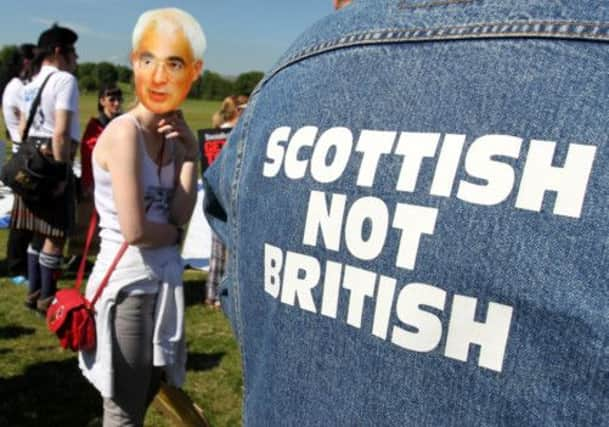Gregor Gall: United in confusion over referendum


United with Labour, launched by former prime minister, Gordon Brown, was the product of growing dissatisfaction within the Scottish Labour Party and its affiliated trades unions that the Better Together Vote No campaign was both inappropriate and deficient for the job of saving the Union. Labour activists, especially amongst the affiliated unions were sharply critical of working with the Conservatives because of the record of what the Thatcher and Major administrations did to society in Scotland as well as the impact of issues like the “bedroom tax”.
But more than that – they also pointed out that the sharp criticism had led (and would continue to lead) to an effective boycott by union and party activists of the Better Together campaign. The result of their non-involvement would be that Better Together would not have the troops on the ground to do the necessary campaigning and canvassing.
Advertisement
Hide AdAdvertisement
Hide AdSo, at the spring 2013 Scottish Labour Party conference, officials such as of Richard Leonard, GMB Scotland political officer, Pat Rafferty, Unite Scottish regional secretary, and Dave Watson, head of equalities and bargaining for Unison Scotland powerfully made the point that Labour needed its own pro-Union campaign.
Alongside Mr Brown at the launch was Labour MP Anas Sarwar, who has been installed as the head of United with Labour. He proclaimed that Labour’s vote No organisation would campaign for “real change in our economic model … [and ] real social change”. These were stirring words, indeed. But they do not sit too easily with Mr Sarwar’s main position as Scottish Labour deputy leader in Scotland as the party has not outlined a vision at either Westminster or Holyrood that matches these words. “Austerity lite” is the continuing grand narrative of Labour in both London and Edinburgh.
So it seems that United with Labour will not easily fulfill its self-ordained duty to provide a positive, alternative case for the Union. This is ironic as those who argue for a distinctive Labour campaign were very critical of Better Together for its negative campaigning against the SNP and Yes Scotland campaign. This likelihood is reinforced by Scottish Labour’s creation of the “2014 Truth Team”, which appears, in effective, to be a negative rebuttal unit which aims to counter claims made by independence campaigners.
The immediate measure of the success of a distinctive and progressive political vision for United for Labour would be the involvement of the three biggest affiliated unions in Scotland, namely, Unite, Unison and the GMB. All three are on the left of the political spectrum, and together they have 383,000 members in Scotland, representing 61 per cent of all the STUC’s affiliated membership.
They, and pretty much they alone, have the capability to provide the activists on the ground that are necessary to do the door-to-door legwork needed for campaigning and canvassing. Over and above that, they also have significant financial resources. Yet, at the moment, all three have yet to declare a position on the Yes/No question through either remaining neutral or undecided. Of the three, the GMB is the only serious prospect at the moment of coming out officially for a No vote. Whether this would mean joining any organisation – or a particular organisation – within the No camp is another issue.
It would be through the involvement of Unite, Unison and the GMB that United with Labour would have some hope of getting to the parts of society in Scotland that Better Together cannot – because of the Tory link. These are the urban, working class communities, particularly in the west of Scotland.
By comparison, Better Together has three union affiliates: Aslef, the train drivers’ union, Community, the former steel and textile workers’ union and Usdaw, the shop workers’ union. But their combined membership in Scotland is below 50,000. The effect of this is that Better Together will be compelled to remain an organisation operating primarily through the mainstream and social media because it cannot summon up the bodies to do the hard physical graft of going round the doors. Moreover, neither Community nor Usdaw have the kind of politics that could make Better Together a more inviting political prospect for the likes of Unite, Unison and the GMB.
On top of all this, United with Labour has to compete for the loyalty of constituency party activists and union members with the Red Paper collective. This was founded in 2012 as a pressure group mostly within Scottish Labour to provide, as it says, “a Labour Movement alternative to the sterile nationalist versus unionist debate around the referendum”. Amongst its notable members are senior MSPs Elaine Smith and Neil Findlay and the Unite Scotland political officer and current chairman of Scottish Labour, Jackson Cullinane, as well as Mr Leonard and Mr Watson. Although small in numbers, its publications punch above their weight because of the figures involved in it. Whether the Red Paper collective seeks to influence United with Labour and work through it or campaign separately remains to be seen.
Advertisement
Hide AdAdvertisement
Hide AdBut it is clear that there are political tensions between it and United with Labour.
All these matters are important because if the No vote does win on 18 September 2014, it will be the balance of forces within the No camp that will largely determine just what a post-referendum Scotland will look like.
• Gregor Gall is professor of industrial relations at the University of Bradford and a resident of Edinburgh